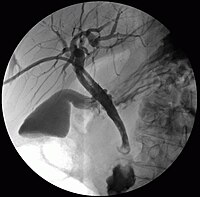
Photo from wikipedia
A combination of a 22-gauge needle and a 0.018-inch guidewire has become popular for patients with an insufficiently dilated bile duct during endoscopic ultrasound-guided biliary drainage (EUS-BD) [1–3]. However, this… Click to show full abstract
A combination of a 22-gauge needle and a 0.018-inch guidewire has become popular for patients with an insufficiently dilated bile duct during endoscopic ultrasound-guided biliary drainage (EUS-BD) [1–3]. However, this combination has several disadvantages, including an insufficient contrast-filled image and limited ability to manipulate the guidewire because of the slimness [1]. Although the catheter must be inserted into the bile duct across the fistula in a challenging situation of this kind, advancing a conventional catheter over a 0.018-inch guidewire can sometimes be difficult because of the gap between the guidewire and the catheter. Here, we report the first use of a new 3-Fr microcatheter that we produced previously [4], which has the following advantages for use with a 0.018-inch guidewire during EUS-BD: (i) it allows easy insertion because of its slimness and flexibility, (ii) it provides a sufficient contrast-filled image, (iii) it assists in manipulating the guidewire to advance into the target space, (iv) it avoids unnecessary dilation until needed, and (v) it allows exchange of the guidewire from 0.018-inch to 0.025-inch to provide support for device insertion (▶Fig. 1). Case 1: A 68-year-old woman, who previously underwent right hepatectomy for hilar cholangiocarcinoma, developed obstructive cholangitis requiring EUSguided hepaticogastrostomy. The advancement of a conventional catheter over the 0.018-inch guidewire failed, whereas the 3-Fr microcatheter was advanced (▶Fig. 2) and a partially covered metal stent successfully deployed. Case 2: A 53-year-old man with obstructive jaundice after subtotal gastrectomy for gastric cancer underwent EUS-guided hepaticojejunostomy. The 0.018-inch guidewire with the 3-Fr microcatheter successfully passed the malignant biliary obstruction (▶Fig. 3); an uncovered metal stent (8 ×60mm) and a plastic stent (7 Fr; 14 cm) were deployed in an antegrade fashion (▶Video 1). E-Videos
Journal Title: Endoscopy
Year Published: 2022
Link to full text (if available)
Share on Social Media: Sign Up to like & get
recommendations!